
I wanted to highlight a few Tennis Elbow Exercise Mistakes in this article.
If you have read my writing over the last six years, you know that I love looking to research for answers, and today is no different. Looking at the research allows me to challenge myself to see if what I am doing is suitable and safe.
Tennis Elbow Exercise Mistake 1. Ignoring Fascia

I have been beating this drum for a while, and it has been highlighted in the Muscle Imbalances Revealed series. Fascia is something we need to think about.
I wanted to talk about fascia and tennis elbow.
There has not been much talk about fascia and tennis elbow, but it is something that I have been doing for years. My clients may get some hands-on work done by a therapist or bodyworker. Still, they need to do what they can to continue the work that the therapist or bodyworker has done, much like flossing between dentist visits. What I encourage my clients to do is self-massage. I know self-massage may not follow the textbook guidelines or what is taught in a fascia course, but it has benefited my clients.
Let’s look at some research that shows the benefit of addressing fascia and tennis elbow.
What they looked at:
The investigators wanted to see if myofascial release reduced pain and functional disability in a group of computer professionals while the control group received sham ultrasound therapy.
A certified practitioner performed the myofascial release techniques, and the test group had 12 sessions over four weeks.
What the Result was:
The group that got myofascial release done had a 78% decrease in pain and functional disability, while the control group had a 7% improvement.
At a 12-week follow-up, the treatment group had a 63.1% improvement in pain and function.
Comments from Rick:
I mentioned above that if you are a computer worker with lateral epicondylitis, myofascial treatment may benefit you.
If you can not get myofascial treatment, try self-massage, as I am sure it will help with your pain and arm function.
Tennis Elbow Exercise Mistake 2. Your Computer Could Be Holding You Back From Recovering

I am working on this month’s Injury of the Month. It is on the tennis elbow. This was the 15th article I looked at, and I thought it was a good fit for the paper I chatted about above. Now, I am digging into the research to see what is new.
What They Looked at:
They wanted to see the factors that lead to successful conservative management of tennis elbow.
They looked at 60 patients with tennis elbows and followed them for six months.
What They Found:
- Repetitive work tasks affected arm function and pain level.
- Neck issues affect the outcome of tennis elbow and lead to lower arm function and more significant pain.
- They suggest those with tennis elbow look at their workstation, posture, and behavior.
Comments from Rick
Not sure what more I can add.
The treatment and exercises are necessary, but equally important are what you do to help yourself recover from the injury. This includes looking at your actions and environment and minimizing things that slow your injury recovery.
Tennis Elbow Exercise Mistake 3. Little Evidence Supporting Stretching
I know this is going to anger a few people.
I know you were taught in a course, or your instructor at college/university said that you should stretch if you have a client with a tennis elbow. Still, the reality is that there is little evidence supporting just doing stretching as the primary activity for tennis elbow.
Looking at the research, more research supports strengthening for tennis elbow than just stretching.
My approach is I use both.
My first preference is to use self-massage in the forearm. Then I will use stretching to address the tension in the forearm, and the focus on the stretch is very light. Then I will work on concentric, isometric, and eccentric strengthening.
There was one article that looked at stretching and strengthening.
What They Looked At:
Ninety-four subjects (50 men) with chronic epicondylitis were randomly put into three groups: stretching only, concentric strengthening with stretching, and eccentric strengthening with extension.
The experiment assigned ice and stretching exercises and limited irritating activities to control for the experiment. Each group performed its set of exercises for six weeks. Two of the groups got an education on their strengthening protocol.
What They Found:
There was no significant difference in the outcome of any one of the groups when it related to pain-free grip strength and function.
Rick’s Comments:
The paper’s focus was on exercise, but as we saw in the paper above, the activities that someone does affect the long-term outcome of tennis elbow. This probably had a more significant factor in the result than they highlighted in their research.
From personal experience, I find people who manage inflammation of their injury also have better recovery results. If you keep doing what hurts, your hurt won’t go away.
If you spend some time on PubMed, you come across several articles that just focus on strength, leading to an improvement in tennis elbow. I talked about one of those papers and tennis elbow exercises a few articles back.
Hey, I hope this helps you out if you have a client with a tennis elbow or tennis elbow.
If you, one of your clients, or if you know someone that has tennis elbow, this will help out:
That is it, have a great day.
Rick Kaselj, MS



